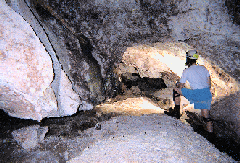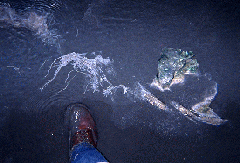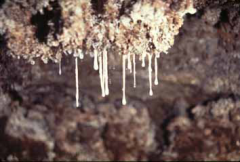Sulfur Cave Microbial Ecology---Cueva de
Villa Luz
Team
Summary
Cueva de Villa Luz, located in southern Mexico in the state of Tabasco
in the Cretaceous limestone, is a moderately size cave (2 kilometers of
passage) with numerous skylights. What makes it so different is the
nasty smell of rotten-eggs from hydrogen sulfide and the passages
teeming with life based on the oxidation of this hydrogen sulfide.
Spiders and their egg cases hang on webs located right next to walls
that are dissolving and whose pH is 0.0 to 0.5. A team of biologists and
geologists joined Jim Pisarowicz, who learned of the cave from the local
people, and Louise Hose, in exploring this fantastic cave in January of
1998.
Interesting Findings
|
|
|
|
Down this passage is some red goo which we sampled. Red goo, a
complex clay breakdown product, ranges from pH 3.9 to pH 2.5.
Clusters of bacterial cells live in this material. How are they
making their living and what is the source of the concentrated rare
earth elements found in the goo?
More about red goo
|
In total darkness are rocks covered with a green slime. In this
case, there were microbial filaments in the stream nearby.
Bacteria-sized cells are present in abundance. Midges cluster on
these rocks in great numbers and may be grazing on the bacteria.
More about green slime
|
Snottites are slimy, dripping stalactites made of goo, that contain
bacteria in abundance and beautiful microscopic gypsum crystal
formations. Both exist at the same time in an environment whose pH
is 0.5! Biovermiculations are worm-shaped deposits on the walls,
which contain numerous bacteria.
More about snottites and biovermiculations
|
Jim Pisarowicz has a bunch of general information about Cueva de Villa Luz.
Preliminary Report on the Biology of Cueva de Villa Luz, Tabasco, Mexico
Kathy Lavoie (State University of New York, Plattsburgh NY, USA),
Diana Northup (University of New Mexico, Albuquerque, NM, USA),
Penny Boston (New Mexico Tech, Socorro, NM, USA),
Carlos Blanco-Montero (Escuela Superior de Agricultura del Valle del Fuerte).
We participated in the January, 1998 Expedition to Cueva de Villa
Luz in Tapihualapa, Tabasco, Mexico, organized by Jim Pisarowicz
and Louise Hose. We present a preliminary overview of the biology
of this interesting cave. Identifications of many species are still
pending. We were initially attracted by the prospects of investigating
a sulfur-based ecosystem, but the actual situation is much more
complicated. Much of the cave is a stream passage, milky-white with
sulfur. Many passages in the cave have very high levels of H2S,
varying during this expedition from 0 to 57-127 ppm. Most passages
were above 10 ppm. The pH of the environment was generally more
acidic than typically found in a limestone cave. Exceptionally low
pHs were associated with "snottites" or microbial veils (pH 0.3-0.7),
and in one area we identified a deposit of bat guano mixed with
gypsum paste which had a pH of 0.0. Sulfate-reducing bacteria were
present in very high numbers (105-106 +) in all sediments. Coliform
bacteria survived in the main stream passage, but were not detected
in springs entering the cave. Microbial involvement is evident in
the formation of white filaments in the cave stream and in microbial
veils suspended from gypsum, possibly in association with webs of
spiders or fungus gnats. There are also significant organic inputs
through numerous skylights and from bat guano and other animals.
Previous studies identified four types of phyllostomid bats in the
caves. We also observed free-tail bats, probably Tadarida brasiliensis,
as well as numerous vampire bats. Bats roosted in good air sections
of passages, but flew freely though bad air passages. The most
abundant organisms are the midges, Tendipes fulvipilus, which are
the main prey for the molly, Poecilia sphaenops, which consumes
both the aquatic larvae and adults. The fish are in turn preyed
upon by a diving hemipterin (not identified). Both fish and midges
are present in very high densities of hundreds to thousands of
individuals in relatively small areas. The fish range from a
cave-adapted form with reduced eyes and no pigmentation to a dark
surface stream form with apparent intergradation between these two
extremes. There was a very high density of predatory invertebrates
throughout the cave, particularly spiders, fungus gnat larvae, and
amblypygids. We found little evidence for terrestrial troglobites,
with the possible exception of a spider and nematodes found in
highly acidic vermiculations. We noted a surprising general lack
of beetles, cave crickets and collembola. Studies to characterize
the species collected are on-going, including molecular phylogenetic
studies of DNA sequences from microbial communities in both terrestrial
and aquatic environments. At the end of the expedition new passages
were discovered in the cave. The new areas are typical limestone
cave passages with good air; future studies of the types, distributions
and abundance of animals in this part of the cave compared with the
sulfur passages will be extremely interesting.
This web site Copyright 2007, 2011, Kenneth
Ingham


